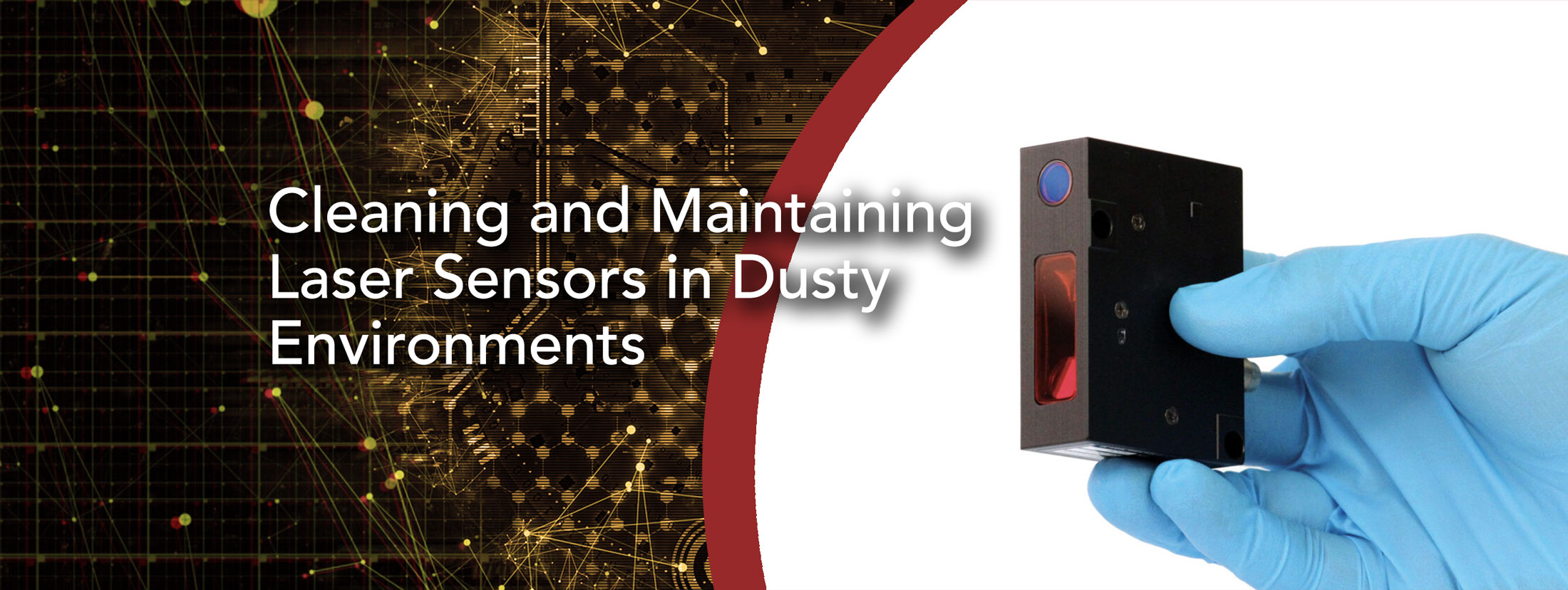Cleaning and Maintaining Laser Sensors in Dusty Environments
Acuity sensors measure distance using light. Similar to anything that communicates with light, items that get in the way are a problem.
When I was a little kid, I was in the way a lot. I’d get caught up daydreaming at almost any time and lose track of the world around me. I’d often walk into the living room, see the TV, and get a bit mesmerized by the moving pictures on the magic box. If I were at my grandma’s house and did this, the spell would always be broken the same way–with my grandma’s voice behind me, “Sarah! You make a better door than a window!”
An Acuity sensor is the TV and dust is your Sarah. Would that make you my grandma…? Okay, this metaphor isn’t perfect!
Jokes aside, it is essential that you keep anything from blocking the light of an Acuity sensor. Dust is one of the most common culprits, but it is often overlooked. Worse yet, many are not aware how easy it can be to damage a sensor’s optics when attempting to remove the dust. That’s not the type of thing that is covered under warranty! This document will help you better maintain your Acuity sensor, and keep your production lines running smoothly.
Prevention is the best medicine
It’s best to try to keep dust off the sensor in the first place. That prevents the dust from blocking the light and reduces the need to clean the sensor. The problem is that there aren’t a lot of ways to keep dust off a sensor.
The simplest solution is to keep the dust out of the air in the first place. Dust mitigation and air filtration can not only keep your sensor working, they have health and safety benefits for the entire company.
Another simple thing to do is setting up the sensor away from sources of dust. This isn’t always possible, but any amount of extra separation from sources of dust reduces the effort needed to keep the sensor clean.
What about an enclosure with a transparent window? That’s only a possibility with our long distance sensors (AR1000, AR2700, AR3000, AS1100, and AS2100), and even then dust will accumulate on the enclosure’s window and cause the same problem. This does, however, protect the sensor from any potential accidental damage from cleaning.
If the sensor absolutely has to operate in a very dusty area, the best way to keep dust off the sensor is with compressed air or an air knife. This should keep the sensor mostly dust free, and help reduce physical cleanings. There is one important thing to keep in mind, however. If the environment is so dusty that it hangs like a fog in the air, the sensor may not be able to see through the dust cloud. At that point, an air knife might not help things.
Unfortunately, total prevention probably won’t be possible, but any steps you take will reduce your downtime and make the hassle of physical cleaning less frequent.
How to clean your laser machine
Whelp, your sensor is dusty and starting to have trouble. What do you do now?
First, let’s talk about the ways that optics can be damaged.
Most people with glasses will be familiar with the problem scratches can cause. A scratch on your glasses causes your eyes to have a harder time focusing. Similarly, a scratched sensor window or sensor lens can disperse light and ruin the focus on the detector. That doesn’t always stop the sensor from working, but scratches will hurt the sensor’s accuracy.
It’s very important to clean optics with the correct tools. Some fabrics, wipes, and applicators are designed to be gentle to optics. It’s important to use these, because many common fabrics can be more abrasive than you realize. Not only that, some cleaning solvents can etch delicate optical glass. Please use only recommended tools and solvents.
But even with the correct cleaning tools, the cleaning procedure is very important. The dust and dirt itself can scratch the optics. When reading our recommended procedure, some of the suggestions may seem overly time consuming or cautious, but remember: you can’t unscratch glass.
Now, with that said, here is our step-by-step guide.
Acuity Laser Optics Cleaning Procedure
- Use compressed/canned air to remove as much dust/dirt as possible.
- Caution: The liquid propellant in canned air can damage optics. If using canned air, the can should be upright and the nozzle should be far enough away to ensure that no liquid propellant sprays on the optics.
- Remove any remaining dust/dirt using a lab-quality cotton tipped applicator and either distilled/deionized water or 99% isopropyl alcohol.
- Caution:
- The cotton tipped applicator should not be used dry.
- The dust/dirt itself can scratch the optics.
- Avoid scratching the optics with the dust/dirt by rotating the applicator as you are cleaning to lift the dust/dirt off the surface and keep clean cotton in contact with the surface of the optics.
- Once the applicator is dirty on all sides, it should be discarded and a clean applicator used.
- Q-tips can be used, but it’s not recommended. Tthey are not manufactured to the same standards as lab-quality cotton tipped applicators, and are more likely to cause scratches.
- It’s important to use distilled water, deionized water, or 99% isopropyl alcohol to avoid leaving residue after cleaning.
- Caution:
- Remove any remaining oil/fingerprints using optical wipes (Such as Kimtech) or cotton tipped applicators with 99% isopropyl alcohol.
- Caution:
- Optical wipes and cotton tipped applicators should not be used dry.
- Use only enough friction as necessary to get the job done.
- It’s important to use 99% isopropyl alcohol to avoid leaving residue after cleaning.
- Caution:
If you have any further questions, you can always contact our friendly tech support team, and they can help guide you in keeping your Acuity sensors dust and scratch free.
DO YOU HAVE A CHALLENGING APPLICATION?
Our sales team has decades of experience in the field finding solutions for our customers’ applications. Please reach out to us at or +1.503.210.5733


